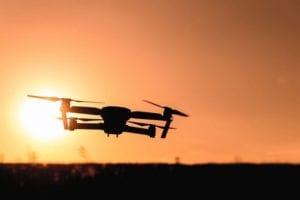The Intelligence Advanced Research Projects Activity (IARPA) is searching for software that will enable biometric identity verification in extremely challenging conditions. The agency is particularly interested in solutions that can function at ranges greater than 300 meters and at the harsh angles that occur when the sensor is placed atop a building or mounted on a drone.

To that end, the agency has issued a solicitation for the Biometric Recognition and Identification at Altitude and Range (BRIAR) program. Organizations interested in participating must submit their proposals by 4:00 p.m. on February 10, while the program itself is expected to kick off in August of 2021 and wrap up by July 31, 2025.
In its briefing, IARPA indicated that proposals should use some combination of face and whole body biometrics. That covers everything from face and stride recognition to characteristics like height, gender, and body type. Regardless of the methodology used, the system needs to be able to overcome atmospheric turbulence, low-resolution images, and other obstacles.
IARPA is ultimately searching for solutions to meet three key performance metrics. The first of those three phases concerns one-to-one identity verification. The winning solutions should be able to match a new long-range image to an existing image with 70 percent accuracy based on face alone, or with 85 percent accuracy when taking the whole body into account.
The second phase is much more lenient, and details one-to-many identification. In that regard, the solutions should have 50 percent accuracy with faces and 20 percent accuracy with the whole body when cross-referencing a new image with a database of old images to search for a potential match.
Finally, the third phase asks developers to create solutions that can get close in a one-to-small-many matching situation. More specifically, IARPA wants the right identity to be one of the top 20 hits 95 and 98 percent of the time with faces and the whole body, respectively. Any biometric matches would presumably inform a more extensive intelligence investigation.
“Expanding the range of conditions in which accurate and reliable biometric-based identification could be performed would greatly improve the number of addressable missions, types of platforms and sensors from which biometrics can be reliably used, and quality of outcomes and decisions,” wrote IARPA in its call.
In the solicitation, IARPA stressed that it is not looking for custom hardware solutions, and is instead interested only in biometric matching software. It also broke the challenge down into bite-sized tasks, such as matching at more than 1,000 meters or mitigating image distortion. IARPA plans to fund multiple projects during Phase 1 of the program, and will make decisions about future Phases based on the success of those projects and the resources available.
The solicitation comes more than a year after IARPA put out a Request for Information as part of the BRIAR program. The organization also ran a facial recognition fusion challenge in 2018.
Source: NextGov
–
December 16, 2020 – by Eric Weiss







Follow Us